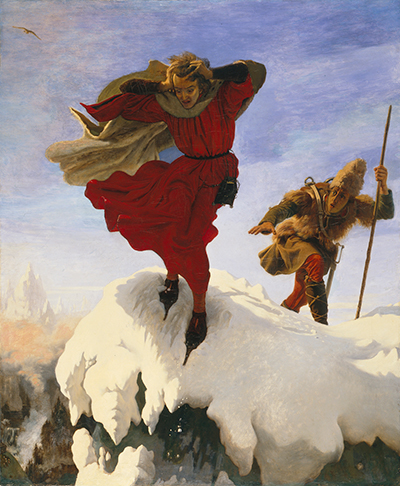The 1842 painting Manfred on the Jungfrau is an arresting work. It stops you in your tracks. This young man, suffering psychological torment, has taken the decision to end his life. But his rescuer is at hand, though he doesn’t yet know that.
As he readies himself to throw his life away by jumping from the Jungfrau’s snowy peak, the viewer of the painting can see the rescuer coming closer. So even though a tragedy has been averted, the young man’s psychological agony is bound to continue, for the immediate time and the time to come in the near future. So when will his torment end? This oil-on-canvas painting by Ford Madox Brown was inspired by a dramatic poem written by Lord Byron. This painter was a specialist in literary paintings, it seems. Other paintings of his were inspired by literary works too. He was obviously a well-read man who enjoyed reading and the dramatic arts.
The question on the viewer’s mind might be, did the artist love the literature or was he simply searching for inspiration? It's an interesting thought. But this artist was definitely a man who enjoyed painting attention-grabbing scenes. Once you’ve feasted your senses and imagination on one of his works of art, you feel as if you've immersed yourself in the story and experienced these emotions too. This painting is in the collection of Manchester City Art Galleries.
Ford Madox Brown was a French-born artist, the son of English parents. He doesn’t appear to have received a lot of education, but he studied his art in continental Europe. His place of study was Belgium, in the cities of Bruges and Antwerp. As a 19th-century artist, he was heavily influenced by the romantic and pre-Raphaelite movements. He painted in watercolours as well as in oils. Just like many of the figures in his paintings, this artist knew and experienced personal tragedies.
He lost his first wife, Elizabeth Bromley to pulmonary tuberculosis when she was only 27 years old. He later got involved with one of his models, Emma Hill. They didn’t marry initially because she was not his social equal, but they married eventually. Several children were born to the artist through both his marriages. But sadly, most of them died, with the exception of two daughters. The celebrated novelist Ford Madox Ford was his grandson, being the son of his younger daughter.




